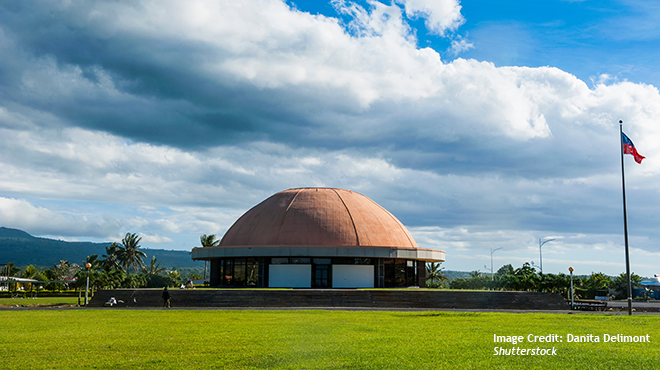Samoa: China’s Pacific Cross-Roads Moment?

When news broke that Samoa’s prime minister elect, Fiame Naomi Mata’afa, would suspend a multi-million-dollar port project financed by the Chinese government it added fuel to the flames of an already existing political crisis. Mata’afa, who is set to become the country’s first female leader, denounced the project as “excessive”. Although she noted that she wishes to maintain good relations with Beijing, she campaigned on catering to local needs, including improving the nation’s health care system. While scrapping the multi-million-dollar project will not upend close ties between Beijing and Apia, the pandemic has brought deep running concerns about Chinese development assistance in the South Pacific to the fore.
A Fateful Shake-Up
It took more than twenty years for Samoan elections to make global headlines. The country’s ruling party, the Human Rights Protection Party (HRPP) under Prime Minister Tuilaepa Sailele Lupesoliai Malielegaoi, suffered a stinging defeat on April 9th. For the first time in more than two decades an opposition party was able to actually challenge the incumbent HRPP, albeit by a narrow margin. Following an initial tie between the HRPP and Mata’afa’s Fa’atuatua I le Atua Samoa ua Tasi (FAST) party it all came down to a single independent candidate to be the kingmaker.
However, the HRPP was able to temporarily counteract its loss with help from the electoral commission which called for an extra seat due to a constitutionally enshrined gender quota. Meanwhile, Samoa’s head of state, Afioga Tuimalealiifano Vaaletoa Sualauvi, and a close ally to PM Malielegaoi, ordered parliament to be dissolved and new elections to be held. Nonetheless, the supreme court overturned the legal challenges, effectively marking the end of the HRPP’s hold on power.
Since then Samoa has remained in political limbo. The HRPP and caretaker PM Malielegaoi have been accused of staging a “bloodless coup”. Besides seeking to deny Mata’afa an electoral majority, she was also literally barred from entering parliament on April 24th and forced to be sworn in in a tent outside the building. Mata’afa had been a member of the HRPP until last year when she broke with the party over a push for constitutional reform. She cited concerns over potential human rights abuses and violations of religious freedom for resigning her post. The ongoing power struggle is the latest episode in a political spat between the old guard and an aspiring challenger.
The Cracks Beneath
The political crisis has challenged a relatively stable, albeit only partially democratic, political system. It has also exposed long-held grievances that Mata’afa and the FAST party have made their top priority. This includes the suspension of the Vaiusu Bay port project financed by Beijing. For years, ties between China and Samoa have been flourishing, expanding quickly from the 1990s. In part, the close ties have historical roots that have been shaping Samoan society. Approximately one third of Samoans are believed to have Chinese heritage. Despite facing harsh discrimination during Samoa’s colonial period, Chinese businesses served as a vital engine for economic growth and became an integral part of society once legal obstacles on intermarriage and cultural exchange were removed.
For Beijing the close cultural ties provide an inroad for bilateral relations. This has helped China call out traditional regional donors with colonial legacies, including New Zealand and Australia, for their patronizing attitudes. Additionally, the “no strings attached” narrative benefitted Malielegaoi and the HRPP who were subsequently able to convert Beijing’s lavish support into political capital. In 2019, both governments signed several cooperation agreements just before the China-Pacific Island Countries Economic Development and Cooperation Forum was held in Apia. The signing was overseen by none other than Chinese vice-premier Hu Chunhua whose presence underscored Samoa’s role as a key Pacific ally. At the same time, two other Pacific nations – the Solomon Islands and Kiribati – officially recognized Beijing marking a major breakthrough for China’s regional agenda.
The Way Ahead
As Samoa continues to struggle with the fallout of the Covid-19 pandemic, political wrangling between Mata’afa and Malielegaoi adds yet another level of uncertainty. With neither candidate willing to concede, everyday-politics are stifled, also impacting foreign relations. Strikingly, neither the majority of Samoa’s Pacific island neighbours nor regional stronghold powers New Zealand and Australia have announced their support for Mata’afa and the FAST party. Since there is no end in sight for the political crisis, China may need to prepare for a further setbacks in Sino-Samoan relations.
Unlike during Malielegaoi’s tenure, Chinese aid provisions may come under closer scrutiny by Samoan officials and the public. It is unlikely that Beijing’s position as a donor will be challenged. Yet, Apia’s political stand-off could indicate that even long-established bilateral relationships can change and development cooperation may have an expiry date. Overall, Chinese aid projects have been met with ambiguity by the Samoan population.
In particular, it appears that the public’s needs for improved healthcare and more effective climate change mitigation mechanisms, have not been sufficiently addressed by Beijing’s financial overtures. Apia’s political turmoil has exposed that Sino-South Pacific relations hinge upon local developments which are inherently fluid, complex, and highly unpredictable.